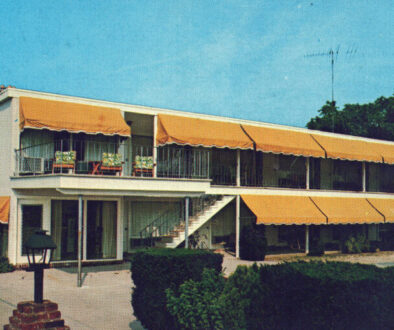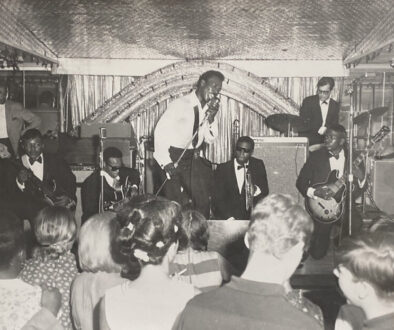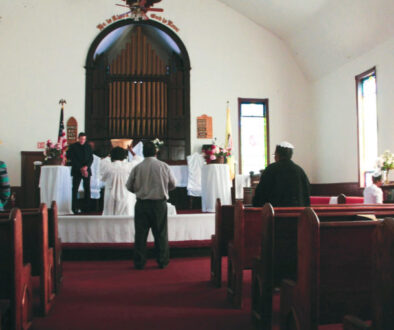Past, Present and Future of the Franklin Street School
This piece contains a historic quote from James S. Kennedy that expresses outdated and racist ideas. Please read with care.
Back in the 1930s, young John Nash, a student at the Franklin Street School, would climb the stairs every morning to Principal Thompson’s office. At precisely 8:45am, he grabbed hold of the rope hanging down through a hole in the ceiling. With a firm tug on it, Nash sounded the first bell of the school day. It signaled that the doors had opened, and children needed to hurry inside Cape May’s elementary school for African Americans.
Just before the bell sounded, female students already started lining up on the east side of the building, in front of a door with a stone lintel engraved with the word, GIRLS. As the bell sounded, a female teacher opened the door. On the other side of the school, Principal Thompson opened the door with BOYS etched above.
At 8:55am, Nash pulled the rope again. And, then again at 9:00am. That was the final bell. The school doors were locked.
The sound of the bells carried out back, past the school’s playground, and over the chain link fence and locked gates that separated the Franklin Street School from a neighboring playground and school—the one for white children—the Lafayette Street School.
Since there was no bell at that school, all the children and teachers in town were guided by the peals from the Franklin Street School bell.
John Nash, later a teacher at the county’s high schools, earned one dollar per month from the Principal for ringing the bell. Other boys did, too. “That was big money for me, cause I was just a little thing,” Nash explained decades later to interviewers with the Center for Community Arts (CCA). The principal paid them out of his own pocket, Nash said, seeing it as a way to develop their sense of responsibility.

The Franklin Street School, built in 1928 for the African American grade school children of Cape May, was not the first segregated school in Cape May. Nor was it the only one in South Jersey, for that matter.
Public education in New Jersey began soon after the Civil War, when the state required that all children be educated, and that towns operate free public schools. Throughout most of South Jersey, unlike the northern part of the state, local governments built separate facilities for black and white students.
Public education in Cape May began even before the state mandate. Around 1860, the Indian Queen Hotel, at Queen and Washington Streets, was converted into a school. But the building was soon declared deficient, partly because, according to the local school superintendent James S. Kennedy, it didn’t provide enough room to adequately separate white and black students.
Kennedy wanted a facility “where the colored classes may also receive the instruction designed for them, without mingling so much with the whole school.” Mixing black and white students “to the minds of some is not a very pleasant reflection and also to the teacher is it oftentimes very annoying…owing to the peculiar temperament of the African race,” Kennedy declared to the Cape May Ocean Wave newspaper in 1861.
To that end, in 1867 a new wood frame building was constructed on Franklin Street, a school for white students. African American students were relegated to a one-room structure across the street.
These facilities sufficed until the turn of the century. That’s when a national civic pride movement, inspiring towns and cities to build substantial, solid, stone and brick government buildings, reached Cape May.
The city built a large, three-story brick school on Lafayette Street, where the Acme loading dock is currently located. This school was only for white elementary students. But, for a time, it also housed the local integrated high school, until a separate building, now City Hall, was built a few years later.
The black grade school students inherited the now somewhat run-down frame building on Franklin Street, which had been the white elementary school. It became known as the Annex.
By 1928, the wooden Annex, which was built just after the Civil War, was extremely dilapidated. It still had outhouses, because indoor plumbing was never installed. It was such an embarrassment to the town that both black and white residents lobbied for a new school for the now substantial African American student body.
Macedonia Baptist Church, an African American Church on the corner of Franklin and Lafayette Streets, sold some of its property to the city for a new school. Cape May built another large brick building in the civic pride tradition, this time the two-story Franklin Street School for African American children.




It had huge windows that filled the rooms with light. And, even better, “we had indoor plumbing,” Sara Edgecombe, a member of the school’s first graduating class, recalled years later. “We didn’t have to go outside, and I used to love that.” It also meant the female students didn’t need to walk past the windows of the jail to use the privy.
Students at the Annex watched with excitement while their new school was constructed, noting in particular the gymnasium attached at the back. They looked forward to playing there. But they were soon disappointed, learning it was only for the high school students. In fact, there was not even a way into it from Franklin Street School. Sometimes though, in inclement weather, the elementary school students did get to use it, but they had to go outside to access it.
Franklin Street School was dedicated in 1928, and students put together a time capsule for the cornerstone. A story has circulated for years among former students that twelve-year-old Dorothy Bose wrote a note, turned it into a paper airplane, and sailed it into the capsule, unbeknownst to school officials dedicating the building.
The building had four large classrooms. Kindergarteners were in with first and second graders. The other three rooms housed two grades each. The rooms were large, and even though combined, the classes were small, with not more than a couple of dozen kids in each room.
The building was new, but the schoolbooks were not. They were hand-me-downs from the white school.
While the practice of segregation was hateful and hurtful, the African American teachers at Franklin Street School tried hard to provide high quality education and instill pride in their students. Emily Dempsey, Sara Edgecombe’s daughter, remembers the environment as “nurturing. They read to us, like your parents would do at home.”
The teachers lived in the area. They would visit students and parents at home, if there were any issues, explained Lois Smith in an interview with CCA. “I lived half a block from the school, and if I didn’t behave myself, I was taken by the hand and taken home and deposited. And my parents were told what I had done. All the teachers went to the same churches we went to, so there was no escape.” But Smith spoke fondly of the teachers, “the dignity and the pride they took in teaching us, and the pride they took in us as neighborhood kids.”
Students remember one teacher, Cordelia Howard Bounds, with particular fondness. At a class reunion in 2007, Joseph Hicks admitted that he was madly in love with her when he was in kindergarten. “I loved that woman,” Dempsey also says, remembering how Bounds rode her bicycle to school. The two kept in touch over the years. “The fact that I [was] still in touch with my kindergarten teacher is special,” said Dempsey, who last saw her former teacher only a few weeks before Mrs. Bounds passed away this past January, at the age of 104.
Bounds, a West Cape May native, taught at Franklin Street School from 1937 to 1945. She graduated first in her class at Cape May High School in 1929, on track to be valedictorian. But two African American boys—including Bounds’ brother—had been recent valedictorians, and school administrators were not willing to have a female African American follow them. “They did not want to name me valedictorian,” Bounds bluntly said in a 1997 CCA interview. Called to the principal’s office, she was told a new graduation plan was suddenly in effect. “This year they would not name a valedictorian or a salutatorian…there would be a first honor student and a second honor student” and a third and fourth, all of whom would give a little speech.
At a time when few students, and particularly African American women, went to college, Bounds earned a degree. Bounds said her father insisted on it. “My children must always be able to earn a living from a profession,” he told acquaintances. “My women are not going to work in some white person’s kitchen.”
The curriculum Bounds and other teachers taught at the Franklin Street School was typical of its time, emphasizing reading, writing and arithmetic. Music and art teachers rotated among all the local schools, including Franklin Street. After school, there were lessons in sewing, embroidery, knitting, chair caning, pottery, and cooking, along with homework help for anyone who needed it.





Students also learned about the important contributions of African Americans to our country’s history and culture, something not taught at the Lafayette Street School. African American history was taught not via books, but through stories. In particular, Principal Thompson, dubbed a “storytelling teacher,” regaled students with stories about African American leaders, such as Frederick Douglass.
Other teachers knew this history from their own life experiences. In the 1940s, Mrs. Owens—who took charge of the school after Mr. Thompson—provided contemporary stories to students about her friend, Mary McLeod Bethune. Ms. Bethune was an educator, philanthropist, civil rights activist, and businesswoman. And she was a close friend of then-president Franklin Roosevelt and first lady Eleanor Roosevelt. They asked Bethune to organize a group of black leaders, dubbed the Black Cabinet, which counseled Roosevelt on racial issues.
Segregated schools operated in South Jersey until the state adopted a new constitution in 1947 specifically prohibiting it. The Franklin Street School closed the next year and all its students transferred to the Lafayette Street School.
Franklin Street School sat vacant until it became the county vocational school in 1960, providing classes and licensing courses in the trades. During the 1970s, it was the headquarters for a federal program providing young people with community service jobs, including in local government offices. Teen dances were held in the gymnasium. The city also used it to store miscellaneous things, such as recovered stolen bicycles.
In the early 1990s, a racially charged incident between the local police and teenagers playing music on the promenade sparked an effort to use the school as a community center for young people. Six white female artists joined with six African American women to form the Center for Community Arts.
Their goal was to preserve and renovate the historic building and use it for arts and humanities programs for young people. They researched its history and conducted interviews with former students and teachers, some quoted in this article. They succeeded in getting the school designated a New Jersey African American Historical Site. It was listed on the New Jersey and National Registers of Historic Places in November 1995.
In 2002, the City of Cape May, which owns the school, provided CCA a long-term lease to rehabilitate the building. Since then, CCA has completed significant rehabilitation and environmental remediation of the building, including replacing the large windows. CCA raised over $700,000 in matching grants, awarded to showcase the city’s African American heritage, and to create a cultural center. But CCA had difficulty raising needed matching funds. The building has been unused in recent years, except for the gymnasium.
A new effort by the City of Cape May, CCA, and the county is evaluating whether the school can serve as an expanded public library, according to Cape May Mayor Chuck Lear. Lear expressed hope, in an open letter in the Cape May Star and Wave, that the building would also include rooms “for community gatherings, art and local history exhibits, African American archives, guest lectures.”
“The preservation and use of the school for community activities was one of the founding missions of CCA,” says the group’s director, David Mackenzie. CCA takes pride in “having saved the building and obtaining its historic designations,” he notes. Now, Mackenzie says, “We look forward to working closely with the city to complete the project and create the multi-purpose community center we have long envisioned.”

“We want it preserved as shared space,” says Dempsey, one of the founders of CCA. “We’d like it named for an African American. But we want it to be a symbol that we can overcome segregation, and reach out and be all inclusive, create something for the entire community.”



